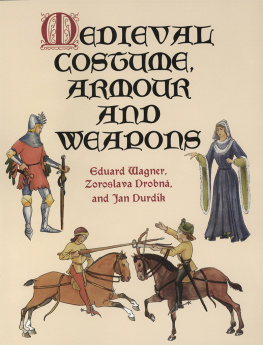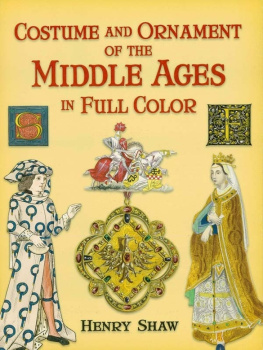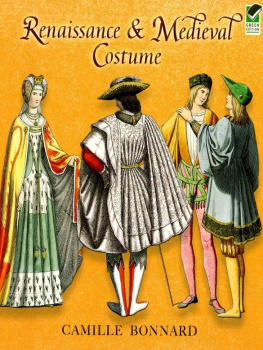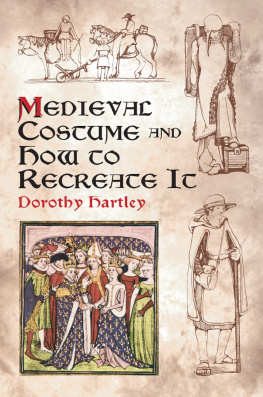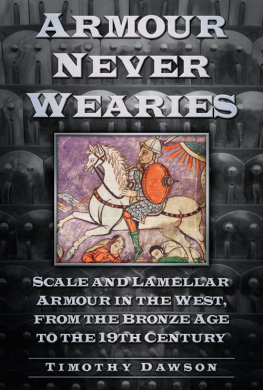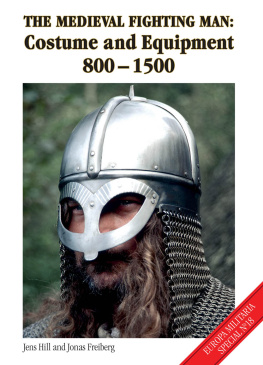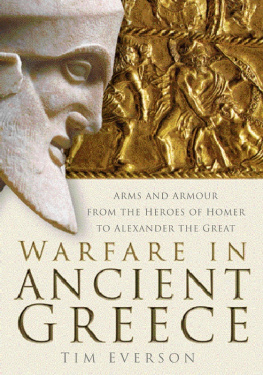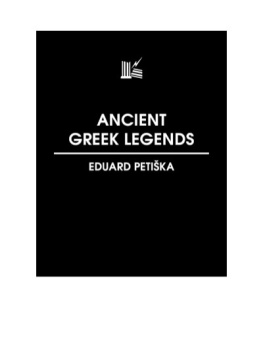Eduard Wagner - Medieval Costume, Armour and Weapons
Here you can read online Eduard Wagner - Medieval Costume, Armour and Weapons full text of the book (entire story) in english for free. Download pdf and epub, get meaning, cover and reviews about this ebook. year: 2014, publisher: INscribe Digital, genre: Religion. Description of the work, (preface) as well as reviews are available. Best literature library LitArk.com created for fans of good reading and offers a wide selection of genres:
Romance novel
Science fiction
Adventure
Detective
Science
History
Home and family
Prose
Art
Politics
Computer
Non-fiction
Religion
Business
Children
Humor
Choose a favorite category and find really read worthwhile books. Enjoy immersion in the world of imagination, feel the emotions of the characters or learn something new for yourself, make an fascinating discovery.
- Book:Medieval Costume, Armour and Weapons
- Author:
- Publisher:INscribe Digital
- Genre:
- Year:2014
- Rating:3 / 5
- Favourites:Add to favourites
- Your mark:
- 60
- 1
- 2
- 3
- 4
- 5
Medieval Costume, Armour and Weapons: summary, description and annotation
We offer to read an annotation, description, summary or preface (depends on what the author of the book "Medieval Costume, Armour and Weapons" wrote himself). If you haven't found the necessary information about the book — write in the comments, we will try to find it.
Medieval Costume, Armour and Weapons — read online for free the complete book (whole text) full work
Below is the text of the book, divided by pages. System saving the place of the last page read, allows you to conveniently read the book "Medieval Costume, Armour and Weapons" online for free, without having to search again every time where you left off. Put a bookmark, and you can go to the page where you finished reading at any time.
Font size:
Interval:
Bookmark:

Plate 14, Part IX, p. 404: A caparison from a painting Equestrian Warfare by Walter vonKlingen.

Plate 14, Part IX, p. 404: A shield, banner and caparison bearing the insignia of Wolfram von Eschenbach.

Plate 73, part II, p. 239: Silder, first half of the fifteenth centurt.

Plate 17, Part I:, p. 89: Figure from the Kaufmann Crucifixion dating from after 1350.

Plate 81, Part I, p. 153: The costume of an English nobleman of the 15th century.

Plate 37, Part I, p. 109: A blacksmithpart of anvil is shown.
Mineola, New York
Copyright
Copyright 2000 by Dover Publications, Inc.
All rights reserved.
Bibliographical Note
This Dover edition, first published in 2000, is an unabridged republication of the work translated by Jean Lay ton, originally published in 1958 by Andrew Dakers, London. The only alteration consists in printing the color plates from the original edition in black and white, several of which are repeated in color on the front and back covers, inside and out. A new Introduction has been specially prepared for this edition.
Library of Congress Cataloging-in-Publication Data
Wagner, Eduard, major.
[Kroje, zbroj a zbrane doby predhusitsk a husitsk. English]
Medieval costume, armour, and weapons / selected and illustrated by Eduard Wagner ; text by Zoroslava Drobn & Jan Durdk; with a new introduction by Vladimr Dolinek.
p. cm.
Originally published: Medieval costume, armour, and weapons (13501450). London : Andrew Dakers, 1958.
Includes bibliographical references.
eISBN-13: 978-0-486-32025-0
1. CostumeHistoryMedieval, 5001500. 2. Arms and armor. 3. Harness. I. Drobn, Zoroslava. II. Durdk, Jan. III. Title.
GT575 .W29313 2000
399dc21
00-038419
Manufactured in the United States by Courier Corporation
41240703
www.doverpublications.com
A lmost half a century has elapsed since this book, Medieval Costume, Armour and Weapons, came into existence. The first editionin the Czech languagewas published in 1956; the English and German translations appeared two years later, and subsequent editions in these languages followed thereafter. Three authors participated: two wrote the text and one did the illustrations.
The portion of the text that covers clothing worn in the period 13501450 is provided by Zoroslava Drobn (19071988), who studied art history at the university in Brno and finished her studies in 19331934 at the university in Florence, Italy. Upon graduation, Drobn worked at the municipal museum in Brno. Following the occupation of Czech regions by Nazi Germany and after the outbreak of World War II, she was imprisoned for a time. In 1940, she was employed by the National Museum in Prague. Drobnas primary focus was medieval art (she published the paper Gothic drawing in 1956, among others) and medieval handicrafts, particularly textile and ceramics.
The author of the text concerning arms and armor is Jan Durdk (born 1923). He studied history at Charles University in Prague and thenuntil his retirement in 1985worked in the military museum in Prague. His specialty was medieval warfare, and in the 1950s his book on Hussite warfare was published in several editions: in Czech, German, and Polish. Durdk then devoted himself to the history of edged weapons and firearms, and published several scientific papers and books. He also co-authored the book Firearms, first issued in 1981, and later published in French and German editions. I remember that at the beginning of my preoccupation with ancient arms, I learned a great deal from Durdks work which, in turn, had considerable influence on the book we co-authored, The Encyclopaedia of European Historical Weapons, published in 1993, and translated in the same year into a French edition, and later into a German one.
The lions share of the credit for the success of this book in achieving an accurate representation of medieval clothing and arms must be ascribed to the illustratorEduard Wagnerdespite the fact that he was not a professional historian, making his approach to the subject quite different from that of his co-authors. Eduard Wagner (19051984) lost his father at the age of fourteen. After leaving elementary school, young Eduard opted for a military career, following the example of his elder brother, Otto Wagner (19021974), who was expatriated after the Nazi occupation of Bohemia and later achieved officers rank in the French foreign legion. Eduard attended the military academy in 19231925, and became an officer in various combatant branches. He began his military career in the mountain infantry, then served as a military horse-trainer, and after that in the air force. In 1929, he survived a plane crash, with the consequences of his injury resulting in a slight speech impairment. Nevertheless, he continued in his military service, first with the army engineers unit, and later, for many years, in his beloved cavalry. After World War IIin October of 1945he was assigned at his own request to the military museum in Prague. Both in paintingwhich had been his hobby since boyhoodand in military history, Eduard Wagner is an exemplar of the self-taught man. He possessed an outstanding ability to match theoretical knowledge with the practical experience of a professional soldier, expert horseman and swordsman.
While Eduard Wagners expertise in the current book is shown mainly in the illustrations, in subsequent books his contribution fully entailed both text and drawings. The most interesting of his books are Cut and Thrust Weapons, issued in many languages (the first English edition was in 1967), and European Weapons and Warfare, 16181648 (the English and German editions appeared in 1979, the French in 1981). Wagners illustrations also accompany the text of many other authors in numerous publications on the subject of military history. Worth mentioning too is the fact that he was the founder of the group Musketeers and Bandits, who have been staging fencing events since 1960 in Prague and abroad. In fact, it was the first group of its kind to organize around the popularity of historic fencing, and continues to flourish in the Czech republic to the present day.
Medieval Costume, Armour and Weapons thus combines the knowledge of renowned historians with the experience of the practitioner well acquainted with matters equestrian and the art of fencing. The authors have drawn from many written and pictorial resources, illuminated manuscripts and period art works, and artifacts from collections in museums and castles. The era from 1350 to 1450 was a crucial one in the development of arms and armor. During this time, firearms became established in European warfare, ending the dominance of armored cavalry and contributing to its replacement by mercenary infantrymen. This was a long and gradual process, and the earliest defeats of armored cavalry can only be inferred by the inception of firearms. However, political and social changes in medieval society are not the preferred topics of the authors, who instead concentrate on the material aspects of warfare and the clothing of the period. Their complex scrutiny is unrivalled in the contemporaneous literature. The book encompasses not only all items of medieval clothing and armor, and all types of arms, but also the technical fittings usually omitted by many authors, as well as various work tools and utensils. It contains not only the appearance of the arms, but also indicates how they had been handled, carried, prepared and used in combat. In its range and complexity of viewpoint lies the prime worth of this publication. And Eduard Wagner had a unique ability to depict the function of the weapon mechanism even to the layperson.
Next pageFont size:
Interval:
Bookmark:
Similar books «Medieval Costume, Armour and Weapons»
Look at similar books to Medieval Costume, Armour and Weapons. We have selected literature similar in name and meaning in the hope of providing readers with more options to find new, interesting, not yet read works.
Discussion, reviews of the book Medieval Costume, Armour and Weapons and just readers' own opinions. Leave your comments, write what you think about the work, its meaning or the main characters. Specify what exactly you liked and what you didn't like, and why you think so.

